One area of embroidery that interests me intensely is ecclesiastical embroidery. For those of you who have been hanging around with me at Needle ‘n Thread for a while, you probably already know that! I got into ecclesiastical embroidery when I was studying for my BA some 20-odd years ago. During a history of art course, I got hooked on the subject, thanks to a book by Pugin that my professor loaned to me.
My Infatuation with Ecclesiastical Embroidery
That book sparked a notorious habit for seeking out examples of ecclesiastical embroidery, visiting museums and sacristies of old churches and secluded convents and taking lots of photos, buying old pieces and studying them, foraging in every corner of the globe (thanks to the internet) for old books on the subject, and pretty much hunting down anything I could get my hands and eyes on that has to do with ecclesiastical embroidery.
It’s been almost a 25 year love affair now with the topic, and I don’t see the infatuation ending any time soon. I am forever learning something new on the subject!
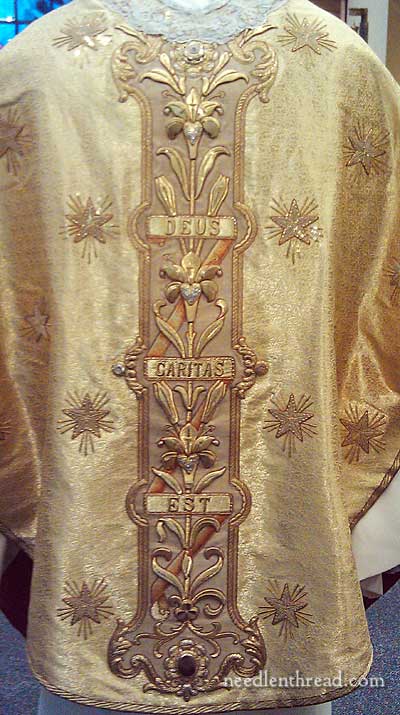
Ecclesiastical embroidery can teach us a lot about the history of needlework, about needlework techniques and materials, about culture, about art, about the connections between spirituality, culture, and art – and the list could go on.
To date, I have over 20,000 photos of ecclesiastical needlework, old and new; I have about 40 books on the subject, published between the mid-1800’s through the mid-1900’s, some that have cost me an arm and two legs (must save one arm for stitching!); I have numerous pieces of old ecclesiastical needlework – from antique fragments, to chasuble backs, to banners and altar frontals, to old altar linens, to entire processional canopies – all beyond use, but excellent for study. I am, in short, a collector and a bit of a junkie on the subject. My friends and family are aware of this fixation, so many of them, when traveling, will take pictures of items of interest that they come across. And that works out pretty well for me!
Goldwork Vestments for St. Therese of Lisieux
And that brings me to today’s topic.
Here in the US we have a National Shrine of St. Therese of Liseux, located in the Chicago area. St. Therese, born in 1873 in Lisieux, France, became a contemplative Carmelite nun at a young age (fifteen years old). She led a happy but short life until she died of tuberculosis at the young age of 24.
St. Therese was canonized in 1925 and is a very popular saint throughout the world. With her Little Way of spirituality that helped her find happiness and peace, she is popular with non-Catholics as well. For example, Gretchen Ruben of The Happiness Project quotes her quite a bit.
St. Therese enjoyed a connection with textiles in her own life. Her mother ran a very successful lace-making business in Alençon, France, which supported the Martin family until Mrs. Martin’s death (of cancer) when she was 45, and when Therese (her youngest daughter) was not quite five years old.
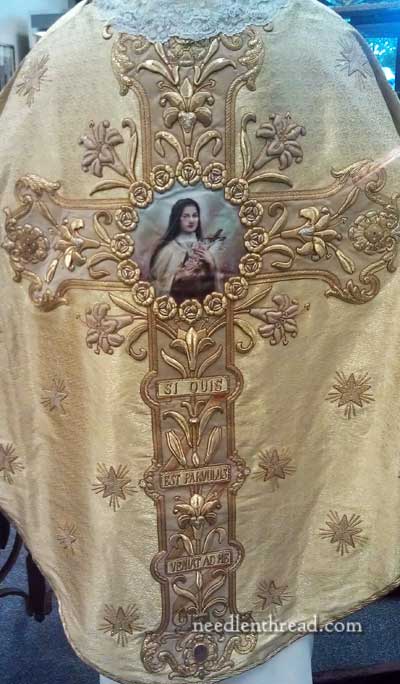
On display at the shrine in Darien, Illinois are some beautiful goldwork vestments that were commissioned in honor of St. Therese by Pope Pius XI, who canonized her. A friend recently visiting the shrine sent along photos of the vestments, which I thought I’d share with you. The techniques involved in creating the vestments are interesting and worth seeing!
Goldwork Chasuble: Points of Interest
The first picture in this article is the front of the St. Therese Chasuble in the museum at the shrine. The chasuble is made from cloth of gold, and the “pillar” on the front and the cross on the back are made from an ivory colored velvet, intricately worked over with goldwork embroidery. The velvet is from the dress Therese wore when she entered the Carmelite convent. The lace at the neck of the chasuble, which you can see in the photo just above, is from the veil Therese wore that day.
The chasuble is interesting for two other reasons:
First, the center medallion on the back of the chasuble is an image of St. Therese painted on silk. This combination of embroidery with a painted medallion or accents on the back of a chasuble is seen more and more frequently from the late 1800’s through the mid 1900’s and beyond. It’s not a combination I like, personally, but I understand why it was done. Already well past the throes of the Industrial Revolution, we became used to “quick.” Painting is much faster than hand stitching this type of portraiture. And as this type of painting became more prevalent, a kind of trend was born.
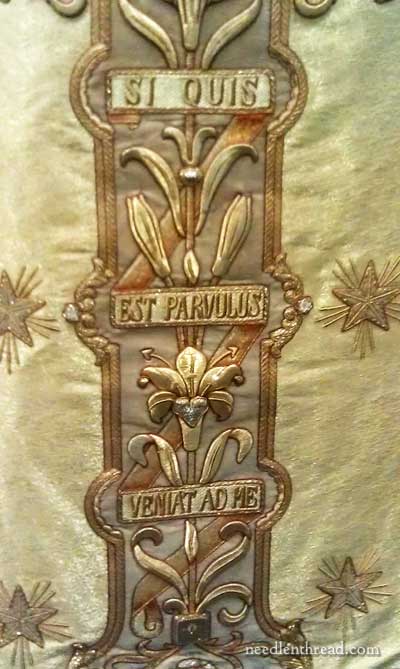
Second, the chasuble is also interesting because it displays, in goldwork, some text on both the front and the back. The text on the front reads (in Latin), “God is Love.” The back reads (from Proverbs 9:4 of the Latin Vulgate) “Let whosoever is a little one come to me.” It is not as common to see text on vestments, though that’s not to say it was never done. I think this is a nice example of text on church vestments.
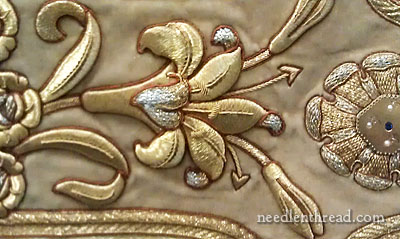
Here, you can see one of the goldwork lilies on the back of the chasuble, on the ivory velvet ground. The lily is stitched in a gold wire thread over cut card shapes, to create very high relief goldwork.
Goldwork Embroidery & Appliqué on the Matching Stole
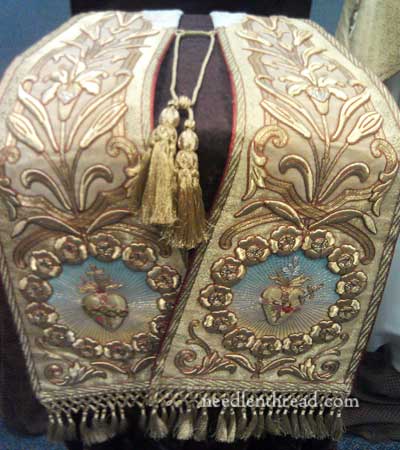
This vestment above is called a stole, and it belongs to the same set as the chasuble above. Here, we see again a combination of painting and embroidery.
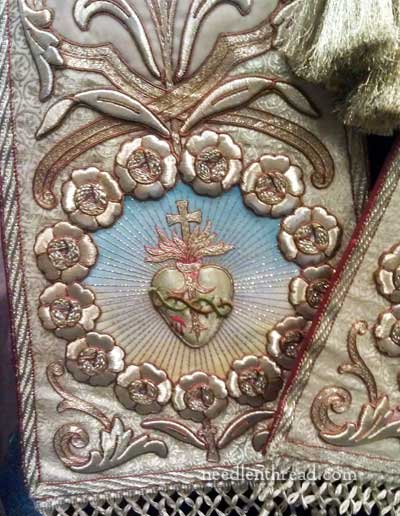
On one side of the stole is featured the Sacred Heart of Jesus and on the other side of the stole is featured the Immaculate Heart of Mary. These two symbols were quite precious to Therese, so it is not surprising to find them somewhere on “her” vestments. The background behind the hearts is painted and then, over the paint, we see radiating lines, which are made from pairs of silver passing thread, couched.
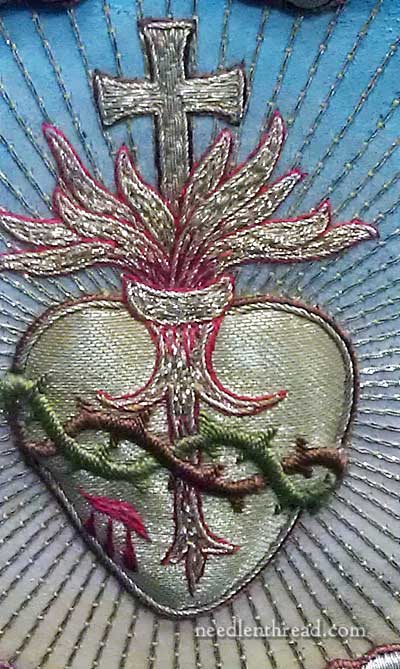
The hearts are made out of cloth of gold, and are appliquéd on top of padding, to create dimension. The padding is probably carpet felt or something similar.
Around the heart appliqué is a gold cord outline, and on the outside of that, a darker outline in brown silk. The thorns on the heart are embroidered in what looks like a heavier silk twist, in satin stitch, the flames are worked with couched threads and outlined in red, and the cross is also worked in couched passing threads.
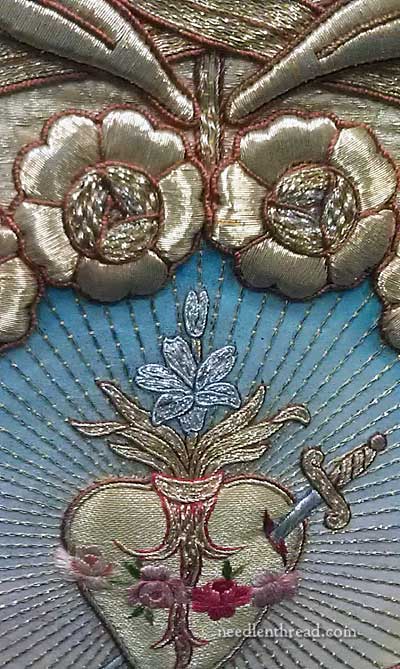
Above, you can see some of the roses from the circlet around each of the hearts. These are worked with couched threads in the center (each center is divided in three sections) and the petals are worked in gold wire thread over card, with an outline of silk worked around them.
Other Pieces of the in the Goldwork Vestment Set
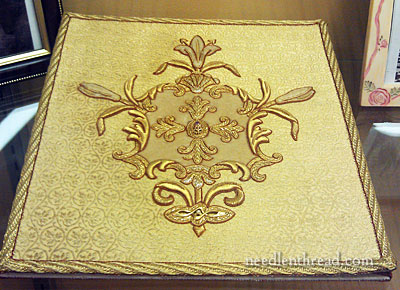
Above, you can see the burse (which is a folder-like piece that holds a small altar linen) that belongs to the same set. The background inside the central design is the same ivory velvet, with high relief goldwork around it. The lily at the top of the central design is also made of the same velvet, appliquéd, and so are the two buds on the side of the design.
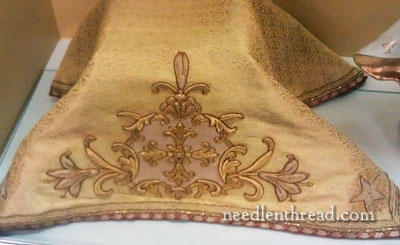
This piece is called the chalice veil. It’s made of the same matching cloth of gold, with the velvet background in the embroidered area, as well as the velvet lilies, and small velvet stars on the corners.
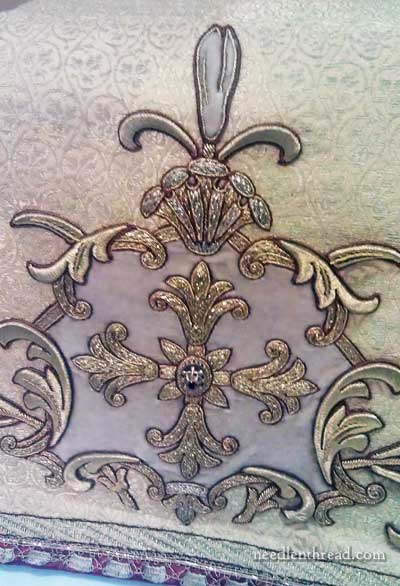
This is closer photo of the embroidery on the chalice veil. In the center of the cross, a little precious stone of some sort is attached. Throughout the vestment set, you can see precious stones and pearls attached here and there. It is likely that these precious stones were given by family or friends to be included in the vestments.
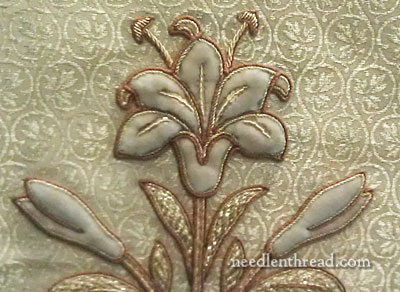
Here’s a close-up on one of the velvet lilies. The veins in the middle of the petals on the center lily are created by small spangles and “s-ing”.
Goldwork Banner
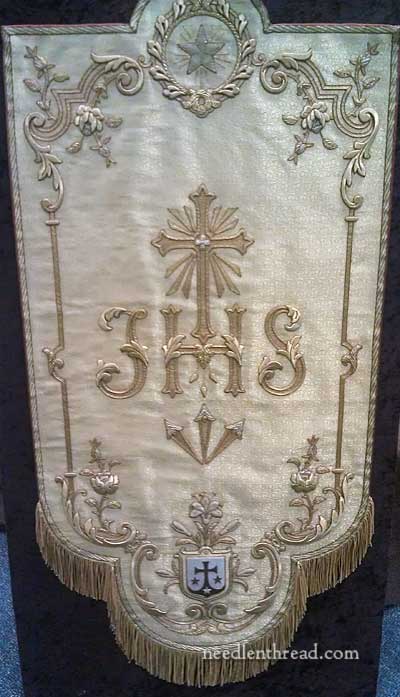
Finally, the set includes this incredible goldwork banner, also worked on cloth of gold. It is a magnificent example of goldwork in relief. You can really see the effect of the gold worked over high relief card on the corner designs and on the lettering. I really love this technique! It is rarely covered in goldwork books, or if it is, it is barely touched on and then passed over quickly. (I’ll be showing you some of high relief goldwork up close in a future article, where I’ll get inside the goldwork and show you what’s there.)
At the top of the banner, in the circle, is a star made from the same ivory velvet that shows up in each piece of the set.
In the center of the large cross in the middle of the banner are four white pearls.
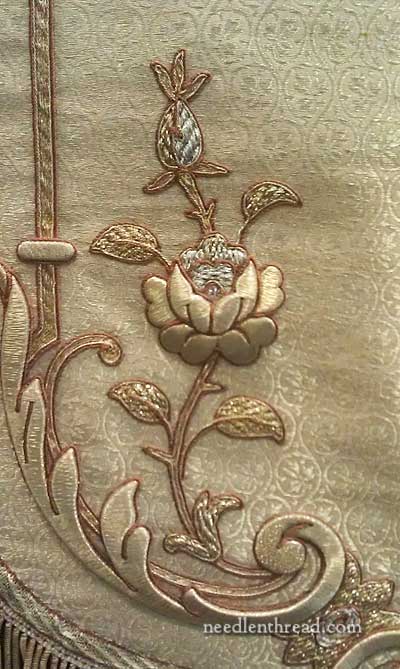
Here’s a close up on that high relief goldwork on a lower corner of the banner. Really exquisite!
I am always struck by the beauty of ecclesiastical embroidery, even when it encompasses styles that I might not personally care for. In ecclesiastical embroidery, we see a myriad of exquisite techniques coming together with a precision and artistry not necessarily seen in too many other areas of the needle arts. Ecclesiastical embroidery also echoes the art forms of the times. Look, for example, at calligraphy and illumination in the Middle Ages and Renaissance – there, you will find ecclesiastical embroidery walking along in perfect sync; look at gothic architecture, and again, you’ll find ecclesiastical embroidery fitting perfectly within the same frame; look at Pugin’s art and architecture, or look at the art and design of William Morris, or the art and architecture of the Arts & Crafts period, and there, you will also find ecclesiastical embroidery mirroring the artistic temperament of the times.
I hope you enjoyed seeing this example of exquisite goldwork! I always figure there’s something to learn from church embroidery, whether there’s an interest in the religious nature of the pieces or not.
Tomorrow, speaking of goldwork, I’ll show you something related to the topic that you may not have seen yet, and the next day, Thread Talk!







I have always sought out these beautiful liturgical work but never tried to contemplate how they were created because the work was so beyond my clumsy embroidery. Thank you for sharing your insights and techniques. Since I started following your blog, I’ve been encouraged to add new embroidery stitches to my needlework. I currently embellishing a quilt for a young girl. I need to decide on my next project so I can finish this one. I’m enjoying it so much that the quilt is in danger of being covered with embroidery. You are in the vanguard of the renewed interest in embroidery. Thank you again.
So beautiful Mary! Thanks for sharing. I sent this link to Gretchen Rubin!
There are beautiful examples of embroidery I would never see, if it wasn’t for Needle & Thread. Thank you, Mary! Your postings always start my day off right!
Wow this is absolutely beautiful! And thanks for all the fascinating details Mary! You really do know so much about this. I love reading these details.
My word, I am filled with questions. One you answered: how do they make the details stand out so far? Another: how long would this take to stitch? Some patterns I have take me almost a year to stitch and they’re nothing like this. And a church type question: it seems most of these fancy vestments and such are from the Catholic church. Do other churches have things like this?
Recently I’ve seen some embroidery work done (very simple) with hand colored fabric. Specific areas were hand colored to add shading for interest. I haven’t seen that before. Much simpler than the painted portrait of course.
Thank you for sharing these beautiful pieces! Such amazing talent.
Mary, every morning I start my day by coming to your website to see what you have posted. I have some modern pieces of gold work on clothing I picked up while living overseas. They used “cardstock” which brings us to today’s posting. I would love to know how they cover the card with gold thread, would you please show how that technique is done. What stitch do they use? Every time I google something to do with embroidery it brings me back to your website. Well done Mary, I have become a loyal fan.
Such beautiful work, and such lovely ground fabrics to have them stitched with. The quality of the velvet, cloth of gold, and the delicate base fabric with the subtle little scroll design are so perfect to set off the embroidery.
One question I have is has anyone worked on the cloth of gold that is currently available? Also, has anyone seen the quality of the cloth of gold and cloth of silver from Watts and Co. in London? I’ve seen the cloth of gold sample from M. Perkins, and well, it is nothing like the fabrics used in these pieces.
Looking forward to learning more! Thanks so much for sharing, Mary!
Stunning! Absolutely stunning. The kind of thing you could pretty much stare at for hours, isn’t it.
This work just takes my breath away. There muist have been several people that worked on all of these vestments, do you think? The cost must have covered by donations, I imagine. Thank you for all of the detailed descriptions. It is so fascinating.
I think of Faberge when I see these beautiful vestments. I love the subtle use of gold and silver combined! Thanks Mary!
Thanks! this may be a good day trip for our upcoming “stay-cation.” These beautiful pieces look like they’d be worth a visit in person.
Thank you so much, Mary. I’m confused. Is the ground fabric which looks to be a jacquard weave or brocade cloth of gold as well? I did not know it was made with a pattern.
I’m getting ready to start a piece over card on velvet with gold. I’ve embroidered over card before and it isn’t that difficult. I’ll keep you posted if the technique works well.
This looks to be French to me, what do you think?
Really beautiful. And I have to try those lilies. Thanks
Hi, Anne – well, today, cloth of gold is rather limited stuff. But you’ll often seen old vestments in cloth of gold that have patterns woven in the cloth. I fact, I’m pretty sure I’ve featured some here on the website.
What type of card are you using for your goldwork? I’ve taken apart this type of embroidery that’s been worked over what looks like tightly stacked parchment paper (many, many layers), and yes… even “card” made from stacked newspaper! Talk about gobsmacked. Newspaper!
I have followed your website for sometime and am always delighted with what you post. You are unfailingly generous with your knowledge and expertise.
You mention having some 40 books on ecclesiastical embroidery. Would you ever consider sharing the titles of those books? Or, for that matter, the titles of other books in your embroidery library?
Thank you for your wonderful website!
Alice
Thank you for sharing these exquisite works of art! Sometimes words cannot do justice to the beauty of the work that is created, and this collection looks to be an example of that. This past summer I had the good fortune to travel to Washington D.C, with friends who insisted we visit a local, “off the beaten path” museum called Hillwood. It is a mansion and former home turned museum of a woman who was the sole heiress to the Post cereal fortune, Marjorie Merriwhether Post. She was married to the American ambassador to Russia back in the 20’s and 30’s. While living in Russia, she began collecting anything and everything she could get her hands on from the Czarist era in Russia as many communists were seeking to destroy these artifacts. She managed to rescue many pieces of Russian China, crystal, and artwork. By far my favorite section of the museum is in a small room at the back of the museum. It holds a collection of ecclesiastical robes and vestments from the early 1900’s that are covered in beautifully preserved golldwork. Having been a fan of your website, I was fascinated to see this incredible collection and enjoyed examining the intracasies of the work through the dimly lit glass. This museum has the largest collection of Russian art, porcelain, and treasures of all sorts in the world. Thanks to the efforts and foresight of a woman with a vision, we can all enjoy this beautiful collection today. The needlework alone is worth the cost of admission. Check it out if you are in the D.C. Area.
Thanks, Pamela! I had the opportunity to visit Hillwood once, but ended up not going because of a glitch in my schedule. Now you’ve convinced me I must get back to DC someday soon! ~MC
Hi Mary,
stole myself a bit of time this morning to read this post, but had to get to work so couldn’t comment. It is wonderful, thank you for sharing those fascinating pictures. I too am totally intrigued by metal over card. I first saw it used when I was living in Denmark, where in the Hedebo district east of Copenhagen it was a technique widely used on back of bonnets during the first half of the nineteenth century. It often blows me away how all the different techniques are integrated and appearing in various forms from around the world. I will certainly look forward to your post about the technique, because as you mention there is so very little written about it.
WOW! Thank you so much for that post. I just bought the A – Z of goldwork and silk embroidery and I’m loving it. Can’t wait to get back to the pall I’m working on. This article has been so inspiring.
WOW Mary! Thank you for this post! It was a beautiful start to a Fall Sunday. Some of the most amazing embroideries ever created were for God so it is more than right to study them. Now get busy and write a book on the subject. Please! Thanks to your friend for sharing the photos and for your excellent interpretation. You are a gift to us all!!
Have you seen this book?:
http://www.amazon.com/High-Fashion-Church-Pauline-Johnstone/dp/1902653602
Yes! I have it….
Hello Mary, My life time goal is to make a gorgeous vestment for a priest that has inspire me. I was wondering since I pursuing a Art degree in College should I buy a vestment to see drawing will fit on the back of it. Or what do you think? I see you have written extensively on the subject and I can’t wait to start reading. Do you have a suggestion where I should start reading. I know I have a lot to remember and a lot to learn I will probably be near death and the priest will be old. I appreciate your help as always!
Thank you,
Sandra
Hi, Sandra – i wouldn’t buy an already finished vestment to embroider on – you’d just have to take it apart to do the embroidery and then put it back together again. Usually, embroidery that’s done directly on a vestment is done before the fabric pieces are even cut out all the way. -MC
Hello Mary where would I find a pattern for a vestment? What part of your blog on vestment would you start reading first?
Thank you,
Sandra
Hi, Sandra –
For embroidery patterns for vestments, I have a Church Patterns e-book available here: https://needlenthread.wpengine.com/church-embroidery-patterns
You can read these articles on the Agnus Dei Project: https://needlenthread.wpengine.com/2010/04/church-embroidery-step-by-step-agnus.html
You can read these articles on the Marian Medallion Project: https://needlenthread.wpengine.com/2011/11/church-embroidery-marian-design.html
You can also find the entire Marian Medallion Project chronicled in this e-book, which takes you step-by-step through the project and includes relevant tutorials, a linked index, etc: http://shop.needlenthread.com/product/the-marian-medallion-project-from-design-to-delivery
And this series of articles on deconstructing goldwork may help: https://needlenthread.wpengine.com/2013/02/deconstructing-goldwork-project-index.html
There’s also the Mission Rose project, which involves techniques used in Church embroidery: https://needlenthread.wpengine.com/2013/04/mission-rose-in-silk-gold-embroidery-project-index.html
You might want to read this article, with links to a really good book (free online) on vestments and embroidery: https://needlenthread.wpengine.com/2007/08/church-embroidery-book-online.html
Please keep in mind that I don’t make the vestments – I just do the embroidery!
Hi, Mary & Sandra, I’ve used several different iterations of patterns and the best are from Elizabeth Morgan at church linens.com her fabric costs more because it is from England. It is wonderful fabric that doesn’t ravel like crazy because of the technique and materials used to make it. Way better than some others and beautiful, ecclesiastical brocades in the right colors.
Elizabth’s patters are comprehensive with excellent instructions. She will also help over the phone with any problems. I can sew but I’m an embroiderer, too, so I know how much she helps.
Mary’s embroidery patterns are great, btw.
Mary I just wanted to know if you knew where I could get a pattern for a vestment?
I bought you ebook quite awhile ago and I love it!
Thank you,
Sandra
Hi, Sandra – I’m afraid I don’t make vestments. You might try that Lucy Mackrille book I linked to above. She might have some layouts in there for making vestments. I can’t remember – but it’s free online, so it’s worth taking a look. Another source is Elizabeth Morgan at churchliness.com – you might check her website for patterns.
Mary, Could you please help me. I am going to draw a highly detailed pattern that is preety large. My question is what would you use to see the drawing to embroider when the fabric is purple?
Thank you,
Sandra
Hi, Sandra – well, I think this varies from person to person. I would use prick and pounce with a light powder, and probably paint the design lines on after pouncing. If you’re planning on tracing or something similar, though, maybe try dressmaker’s carbon in white, yellow, or even red.
Beautiful St Therese chasuble! How many days for work? It is designed by the commettee? How much the low-mass set costs? THX
a dir poco meraviglioso complimenti
sartoria chinello maria antonietta
Thank you for posting this article and accompanying pictures of the St Therese Vestment. Stunningly exquisite artwork is the embroidery, made all the more beautiful for being used in liturgical worship of God for His glory.
I have an old image of St Theresa around 12×14 and it’s all done in silk thread. I assume my mom got it from her mom I’m not sure. I have no idea of age I would guess 1930’s or earlier. I have a Masters in Public History and in all my research I’ve never come across another like it. Would you have any information on it? I can email you pictures if that would help. Thank you in advance for your time.
Steve Hicks
Hi, Steven – It could have been something done as a memento of her canonization, which was in 1925. It sounds interesting and I’d love to see it. If you’d like to send photos, just respond to this comment, which should show up in your email inbox.